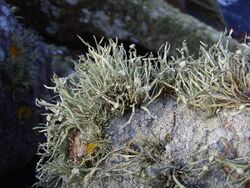Biology:Ramalina siliquosa
| Ramalina siliquosa | |
|---|---|

| |
| Scientific classification | |
| Domain: | Eukaryota |
| Kingdom: | Fungi |
| Division: | Ascomycota |
| Class: | Lecanoromycetes |
| Order: | Lecanorales |
| Family: | Ramalinaceae |
| Genus: | Ramalina |
| Species: | R. siliquosa
|
| Binomial name | |
| Ramalina siliquosa (Huds.) A.L.Sm. (1918)
| |
| Synonyms[1] | |
|
Lichen siliquosus Huds. (1762) | |
Ramalina siliquosa, also known as sea ivory,[2] is a tufted and branched lichen which is widely found on siliceous rocks and stone walls on coastlands round the British Isles, occasionally slightly inland. It grows well above the high-tide mark but is still very tolerant of salt spray. The branches are flattened and grey, and bear disc-like spore-producing bodies. It forms part of the diet of sheep in Shetland and on the coast of North Wales.[3] It is found in Iceland where it has a conservation status of a vulnerable species.[4]
Taxonomy
The species was originally described as Lichen siliquosus by the botanist William Hudson in 1762.[5] It was transferred to the genus Ramalina by Annie Lorrain Smith in 1918.[6]
References
- ↑ "Ramalina siliquosa (Huds.) A.L. Sm. 1918". MycoBank. International Mycological Association. http://www.mycobank.org/MycoTaxo.aspx?Link=T&Rec=403830. Retrieved 2011-06-08.
- ↑ "MOSSES, LICHENS, FUNGI AND FERNS IN CORNISH HEDGES". 2019. p. 10. http://www.cornishhedges.co.uk/PDF/mosses.pdf.
- ↑ "Sea ivory - Ramalina siliquosa". MarLIN. The Marine Life Information Network. http://www.marlin.ac.uk/speciesinformation.php?speciesID=4235. Retrieved 2013-10-19.
- ↑ Icelandic Institute of Natural History (1996). Válisti 1: Plöntur (in Icelandic). Reykjavík: Náttúrufræðistofnun Íslands.
- ↑ Hudson W. (1762) (in Latin). Flora Anglica. p. 460.
- ↑ Smith AL. (1918). A Monograph of the British Lichens. 1 (2 ed.). p. 172.
Wikidata ☰ Q7288841 entry
 |

